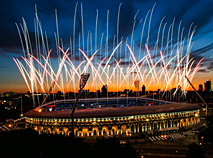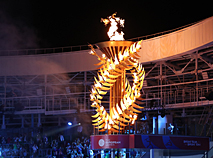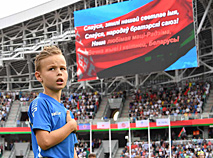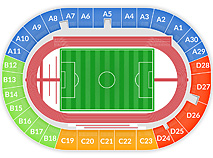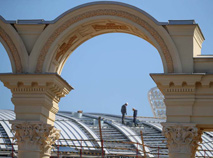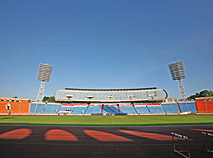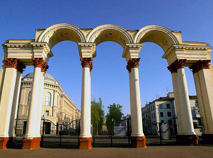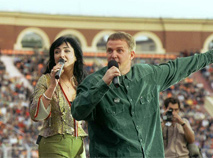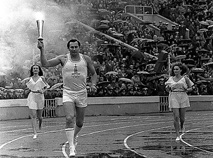Dinamo Stadium
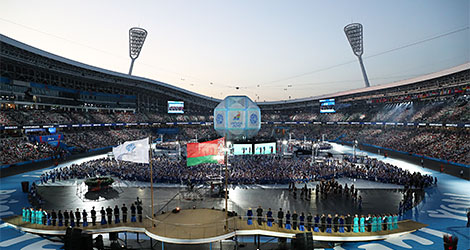
The legendary Dinamo Stadium which history goes back more than 90 years is one of the most impressive structures in Minsk. In June 2018 it reopened after extensive renovations and in October was awarded the highest classification category. In the summer of 2019 the stadium hosted the major events of the 2nd European Games: the opening and closing ceremonies, an athletics tournament.
History
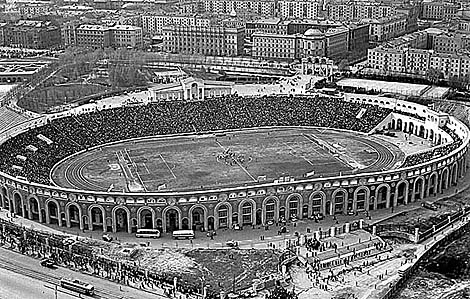 Minsk-based Dinamo Stadium is a unique facility familiar to every generation of Belarusian athletes and fans. The stadium was inaugurated on 12 June 1934. Originally the open-air stands seated 10,000 people. It was the reason for the first renovation project (1937-1938) to increase the seating capacity to 12,000.
Minsk-based Dinamo Stadium is a unique facility familiar to every generation of Belarusian athletes and fans. The stadium was inaugurated on 12 June 1934. Originally the open-air stands seated 10,000 people. It was the reason for the first renovation project (1937-1938) to increase the seating capacity to 12,000.
In the first days of the Great Patriotic War, 24 and 25 June 1941, the German air raid put Dinamo Stadium on fire destroying it almost to the ground. Decades later, during the renovations, builders found a wartime 76-millimeter artillery shell at the stadium.
Post-war reconstruction began in 1946, the first football match took place on 12 June 1948. However, it took seven years for the full recovery of the stadium (1947-1954). The project architects were V. Volfenzon, N. Kolli, M. Parusnikov, N. Schmidt, S. Satunts and E. Sharkov.
Olympic Games in Minsk
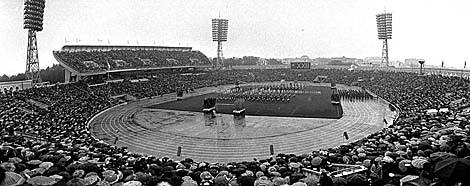 The reason for the second renovation project in 1978-1980 was the qualifying football matches ahead of the 1980 Olympic Games. The project provided for a new scoreboard and lighting masts, the second tier of stands (to increase the seating capacity to 50,000), fully-equipped special room for doping control and a room for media.
The reason for the second renovation project in 1978-1980 was the qualifying football matches ahead of the 1980 Olympic Games. The project provided for a new scoreboard and lighting masts, the second tier of stands (to increase the seating capacity to 50,000), fully-equipped special room for doping control and a room for media.
A big sculptural group Run by famous architect and sculptor Valentin Zankovich became a notable addition to the stadium’s design. Located at the staircase near one of the entries, this sculptural group depicts three hovering athletes.
The Olympic Bowl became another draw of the stadium. On 20 July 1980 a symbolic fire was lit in a solemn ceremony at the stadium. The final part of the ritual was performed by three-time Olympic champion, seven-time world champion Aleksandr Medved. Today the torch that was once held by the outstanding wrestler is in the holdings of the Museum of the National Olympic Committee of Belarus.
Dinamo Stadium in the 1990s
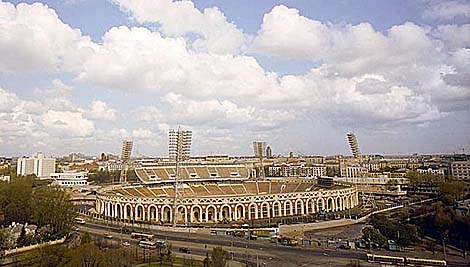 In the late 1980s-early 1990s the stadium no longer served its initial purpose: it was used as a market place at daytime and as a concert venue at night. It saw many Soviet and international music stars, like Igor Talkov, Viktor Tsoi and his Kino band, Yuri Shevchuk and DDT, a-ha, Panik, The Prodigy. The record was set by Alla Pugacheva who gave eight solo concerts on 16-20 August 1989 with a total audience of 400,000.
In the late 1980s-early 1990s the stadium no longer served its initial purpose: it was used as a market place at daytime and as a concert venue at night. It saw many Soviet and international music stars, like Igor Talkov, Viktor Tsoi and his Kino band, Yuri Shevchuk and DDT, a-ha, Panik, The Prodigy. The record was set by Alla Pugacheva who gave eight solo concerts on 16-20 August 1989 with a total audience of 400,000.
In 1999 the Dinamo Stadium was renovated. For the first time its wooden benches were replaced by seats, which decreased its seating capacity from 50,000 down to 34,000.
Dinamo Stadium is a home arena for Belarusian football clubs
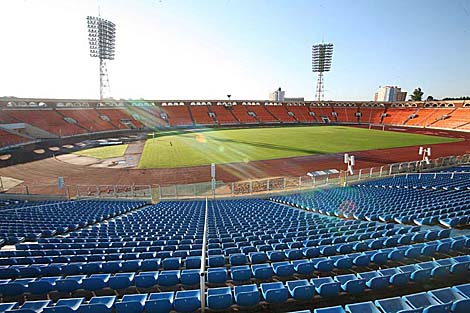 In 2009 the stadium became a training venue and a home ground for the Dinamo football club.
In 2009 the stadium became a training venue and a home ground for the Dinamo football club.
In 2008-2013 it was the training venue for FC BATE, the country’s most successful football club. The stadium was also FC BATE’s home ground for three seasons as the club took part in the group stage of the Champions League.
Dinamo Stadium renovation
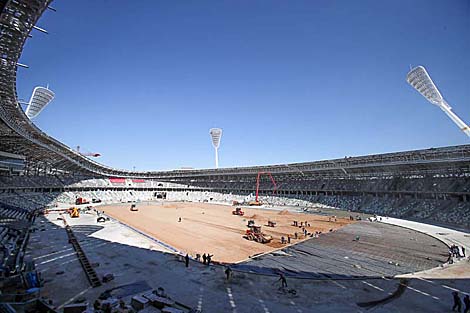 The third renovation was launched in 2012. It was the biggest and longest renovation effort in the history of the sports venue. It lasted six years and was over in May 2018.
The third renovation was launched in 2012. It was the biggest and longest renovation effort in the history of the sports venue. It lasted six years and was over in May 2018.
The architects had to create a sports complex of an international level while preserving the historical look of the stadium intact, including plasterwork on the facade, the famous entrance arc of 1953, the Olympic Bowl, and the Run composition.
The construction workers dismantled some of the stands on the first floor. New premises were created for athletes, judges, coaches, as well as a conference hall by reducing the seating capacity of the stadium to 22,000.
At present Dinamo Stadium looks modern and functional thanks to a round canopy made of metal structures that protect up to 80% of the seats from bad weather, and thanks to the glass-paned part of the facade from the side of Kirova Street.
The lighting system comprises about 100 LED projectors on four light towers (each weighs 120 tonnes and is 68m high). Additional devices, sound systems, and CCTV cameras are installed under the canopy.
The “sports core” of the stadium changed dramatically. Now the stadium has new athletic tracks (nine in the main arena and four in the training area) with an IAAF-recommended surface resistant to UV radiation and weather conditions.
The field (105m by 68m) is covered with natural glass and can host football games. The territory is divided into sectors for field-and-track competitions: jumping, shot put, spear, disc and hammer throwing, there is a pit for steeplechase running.
Dinamo Stadium infrastructure
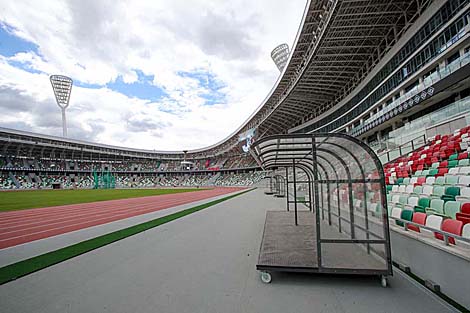 After the renovation, a media center that can seat 200 people was opened at the second level of the western stand. The center has a storage room for photo graphic equipment (300 slots), two offices for big photo agencies and newspapers, a workshop to repair photographic equipment, and a comfortable press bar (40 seats).
After the renovation, a media center that can seat 200 people was opened at the second level of the western stand. The center has a storage room for photo graphic equipment (300 slots), two offices for big photo agencies and newspapers, a workshop to repair photographic equipment, and a comfortable press bar (40 seats).
In order to provide guests with mobile communication, specialists installed 32 antennas under the dome of the stadium and over 260 additional antennas inside. The system uses the UMTS and GSM standards, supports the LTE technology, and provides users with the 4G network.
A total of 58 catering facilities are located along the perimeter of the stands (northern, eastern, and southern). The stadium offers 137 parking places in the underground garage and over 350 places along the fence and in the adjacent streets.
Interesting facts
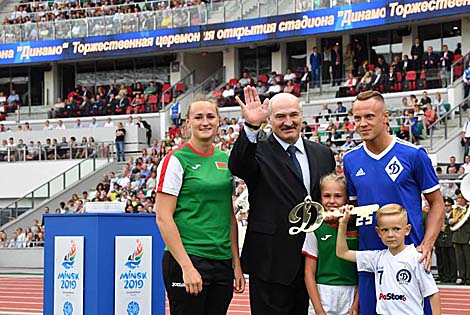 The festive opening ceremony of Dinamo Stadium after the renovation took place on 21 June 2018. It was attended by Belarus President Aleksandr Lukashenko and President of the International Association of Athletics Federations (IAAF) Sebastian Coe.
The festive opening ceremony of Dinamo Stadium after the renovation took place on 21 June 2018. It was attended by Belarus President Aleksandr Lukashenko and President of the International Association of Athletics Federations (IAAF) Sebastian Coe.
The first thing that thousands of attendees and TV viewers heard was the voice of Leonid Bogdanovich who had been a commentator at the stadium from 1996 till the renovation in 2012.
After the welcoming speech, the Belarusian head of state gifted a symbolic key from the stadium to Belarusian athletes - members of the national athletics and football teams, and started the countdown to the European Games.
The renovated stadium was tested by the famous Belarusian athletes – Aleksandr Hleb, Mikhail Gordeichuk, Denis Shcherbitsky, Maksim Bordachev. The opening evening saw a football match that ended with the victory of the combined team of Dinamo Minsk and Dynamo Brest clubs over the combined team of the Belarusian Cup clubs 4-3.
The first official competition at the renewed Dinamo Stadium was an athletics event between the teams of Belarus, Ukraine, Baltic and Balkan countries on 22 June.
Following the “test drive” (the opening ceremony and the athletics event) the stadium hosted over 1,000 Minsk residents for the charity SunRun Challenge on 23 June to support children with Down’s syndrome.
The first international football match at Dinamo Stadium turned lucky for the Belarusian national team. The debut match in the 2018 UEFA Nations League home series ended with Belarus celebrating a 5-0 victory over San Marino.
A new format of athletic competitions was tested at the stadium in September 2018. The Dynamic New Athletics (DNA) featured all ten types of the program which included the traditional triathlon disciplines: Run, Jump, and Throw.
In October 2018 Dinamo Stadium was assigned UEFA Category 4, which, according to the UEFA Stadium Infrastructure Regulations, allows the stadium to host matches of the Nations League, qualifiers of the world and European championships involving national teams and also group stage matches and play-offs of the UEFA Champions League and UEFA Europa League.
Belarus bid to host the 2024 European Athletics Championships at Dinamo Stadium.
Getting to Dinamo Stadium
Dinamo Stadium is located at 8 Kirova Street in Minsk downtown, in close vicinity to Nezavisimosti Square and the Railway Station. Metro is the fastest way to get to the stadium. The closest metro stations are:
-
Ploshchad Lenina and Oktyabrskaya (Moskovskaya Line, blue);
-
Pervomaiskaya and Kupalovskaya (Avtozavodskaya Line, red).
Other forms of transport serve the Dinamo Stadium area as well:
Tram routes No. 1, 4, 7 and bus routes No.127 stop at the bus stop Stadion Dinamo;
Trolleybus routes No. 3, 5, 6, 16, 20, 30, and bus routes No. 79, 102, 123, 79д, 3с, 81э, 175э all run past the bus stop Tekhnologicheskiy Universitet.


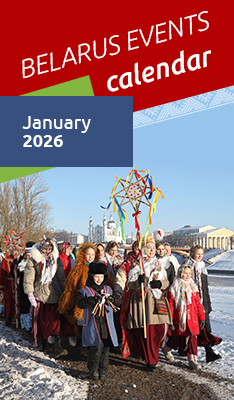




 print version
print version make home page
make home page add to bookmarks
add to bookmarks